
Bohemian Waxwing, Chris Wood
Continental Summary
A late period arrival of favorable conditions will see light to moderate movements, primarily waterfowl, in the West, while the first half of the period in the East will see moderate flights scattered across the region.
Wondering what species are migrating through right now? Check out our analysis for the past 7 days.
Arrows show wind speed and direction (arrow points in the direction to which wind is blowing) 100 m above ground level. Areas with southerly winds are colored red; northerly winds colored blue. Accumulated precipitation (in 6 hour intervals) is green, outlined by white. Broadly speaking, areas of the map in blue will experience conditions that are favorable for migration, and areas where blue and green (and red and blue) intersect and overlap may experience migrant concentrations and fallouts as migrants interact with precipitation.
We use data collected by eBird users help make more accurate forecasts. If you enjoy the predictions contained in these posts, please consider submitting your own bird sightings to eBird to even further improve the content. Every observation counts, whether it be a single bird at a feeder in your backyard, or an entire day spent in a national park. To get started with eBird, head on over to the site!
Need a review of our definitions for regions, species on the move, and migration amounts? Please visit this link.
Quick Links to Regions
Upper Midwest and Northeast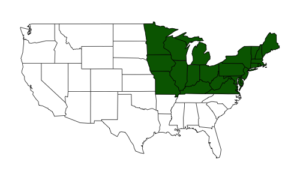 |
Gulf Coast and Southeast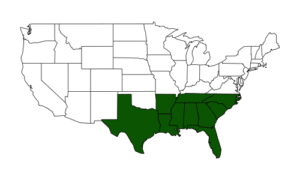 |
Great Plains |
West |
Upper Midwest and Northeast
With the passage of another cold front and the arrival of more seasonally appropriate temperatures, the weekend will bring moderate to locally heavy flights in the Upper Midwest and New England. Patches of favorable conditions persist in the region and span the remainder of period from Sunday through Thanksgiving, and where conditions are favorable light to moderate flights will continue. Note in particular another substantial frontal boundary is forecast to pass through the region later in the work week, and birders should watch carefully for possible displacements of late season western vagrants. Additionally, coastal interests should monitor the winds after Thanksgiving, as coastal flights of waterfowl and near shore pelagic birds are likely on the following Friday and Saturday.

Pied-billed Grebe, Ryan Schain
Species on the Move
Beginning Arrivals What is this?
Peaking Arrivals
| Species | Noticeability | Migrants Begin Arriving | Rapid Migrant Influx | Peak | Rapid Migrant Departure | Last Migrants Depart |
|---|---|---|---|---|---|---|
| Snow Goose | * | 18-Sep | 21-Nov | 26-Dec | - | - |
| Common Merganser | ** | 13-Oct | 25-Nov | 22-Dec | After Dec 31 | - |
| Snowy Owl | * | 8-Nov | 25-Nov | After Dec 31 | - | - |
| Short-eared Owl | * | 11-Oct | 27-Nov | 18-Dec | - | - |
Beginning Departures
| Species | Noticeability | Migrants Begin Arriving | Rapid Migrant Influx | Peak | Rapid Migrant Departure | Last Migrants Depart |
|---|---|---|---|---|---|---|
| Bufflehead | *** | 18-Oct | 1-Nov | 21-Nov | 4-Dec | 13-Dec |
| Tundra Swan | ** | 25-Oct | 6-Nov | 22-Nov | 5-Dec | 13-Dec |
| Red-throated Loon | * | 16-Oct | 3-Nov | 22-Nov | 5-Dec | 15-Dec |
| Rufous Hummingbird | * | 27-Oct | 8-Nov | 22-Nov | 6-Dec | 16-Dec |
| Ash-throated Flycatcher | * | 30-Oct | 10-Nov | 25-Nov | 11-Dec | - |
| Hooded Merganser | ** | 20-Oct | 4-Nov | 26-Nov | 9-Dec | 24-Dec |
Ending Departures
| Species | Noticeability | Migrants Begin Arriving | Rapid Migrant Influx | Peak | Rapid Migrant Departure | Last Migrants Depart |
|---|---|---|---|---|---|---|
| Green-winged Teal | *** | 8-Aug | 22-Aug | 27-Oct | 22-Nov | 10-Dec |
| Pied-billed Grebe | *** | 12-Sep | 10-Oct | 31-Oct | 22-Nov | 11-Dec |
| Red-necked Grebe | * | 6-Oct | 19-Oct | 7-Nov | 22-Nov | 8-Dec |
| Snow Bunting | ** | 12-Oct | 23-Oct | 9-Nov | 22-Nov | 1-Dec |
| American Wigeon | * | 9-Sep | 5-Oct | 1-Nov | 23-Nov | 19-Dec |
| Surf Scoter | * | 23-Sep | 11-Oct | 8-Nov | 26-Nov | 8-Dec |
| White-winged Scoter | * | 1-Oct | 19-Oct | 10-Nov | 26-Nov | 8-Dec |
| American Coot | *** | 26-Sep | 14-Oct | 6-Nov | 26-Nov | 20-Dec |
| Western Kingbird | * | 15-Oct | 26-Oct | 9-Nov | 26-Nov | 7-Dec |
| Fox Sparrow | *** | 30-Sep | 17-Oct | 8-Nov | 26-Nov | 10-Dec |
| Ring-necked Duck | ** | 5-Oct | 21-Oct | 12-Nov | 27-Nov | 12-Dec |
Gulf Coast and Southeast
The last moderate and locally heavy flights of the season occur this period, first with a flight in the southeastern coastal plain on Friday night and then with flights that are more widespread from the southern Appalachians through the Texas coastal Plains for Saturday through Monday. Light to locally moderate flights continue through the remainder of the period locally in the southeastern coastal Plain as the remainder of the region sees largely unfavorable conditions for late season movements.
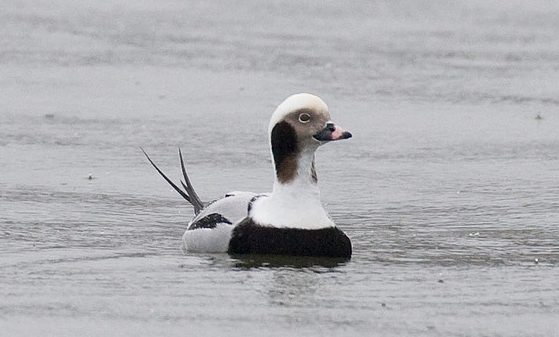
Long-tailed Duck, Chris Wood
Beginning Arrivals What is this?
| Species | Noticeability | Migrants Begin Arriving | Rapid Migrant Influx | Peak | Rapid Migrant Departure | Last Migrants Depart |
|---|---|---|---|---|---|---|
| Short-eared Owl | * | 21-Nov | 4-Dec | - | - | - |
| American Woodcock | * | 22-Nov | 3-Dec | 24-Dec | - | - |
Peaking Arrivals
| Species | Noticeability | Migrants Begin Arriving | Rapid Migrant Influx | Peak | Rapid Migrant Departure | Last Migrants Depart |
|---|---|---|---|---|---|---|
| Red-breasted Merganser | ** | 4-Nov | 22-Nov | After Dec 31 | - | - |
| Harris's Sparrow | * | 6-Nov | 23-Nov | 15-Dec | - | - |
| Common Goldeneye | * | 12-Nov | 27-Nov | 21-Dec | - | - |
Beginning Departures
| Species | Noticeability | Migrants Begin Arriving | Rapid Migrant Influx | Peak | Rapid Migrant Departure | Last Migrants Depart |
|---|---|---|---|---|---|---|
| Double-crested Cormorant | * | 25-Sep | 17-Oct | 21-Nov | 27-Nov | 1-Dec |
| Ruddy Duck | ** | 14-Oct | 29-Oct | 25-Nov | 15-Dec | - |
Ending Departures
| Species | Noticeability | Migrants Begin Arriving | Rapid Migrant Influx | Peak | Rapid Migrant Departure | Last Migrants Depart |
|---|---|---|---|---|---|---|
| Franklin's Gull | ** | 8-Oct | 20-Oct | 5-Nov | 21-Nov | 4-Dec |
| American Avocet | * | 1-Sep | 20-Oct | 5-Nov | 24-Nov | 8-Dec |
| Dunlin | * | 9-Oct | 23-Oct | 14-Nov | 26-Nov | 7-Dec |
| Western Meadowlark | * | 3-Oct | 19-Oct | 10-Nov | 26-Nov | 8-Dec |
| Double-crested Cormorant | * | 25-Sep | 17-Oct | 21-Nov | 27-Nov | 1-Dec |
Great Plains
Scattered moderate flights punctuate the weekend as a disturbance clears out of the region. However, the days that follow see a period of largely unfavorable conditions that will not spawn much late season movement. The arrival of more favorable conditions comes just before Thanksgiving, when light to locally moderate flights, primarily of waterfowl and late season sparrows and allies, will occur.
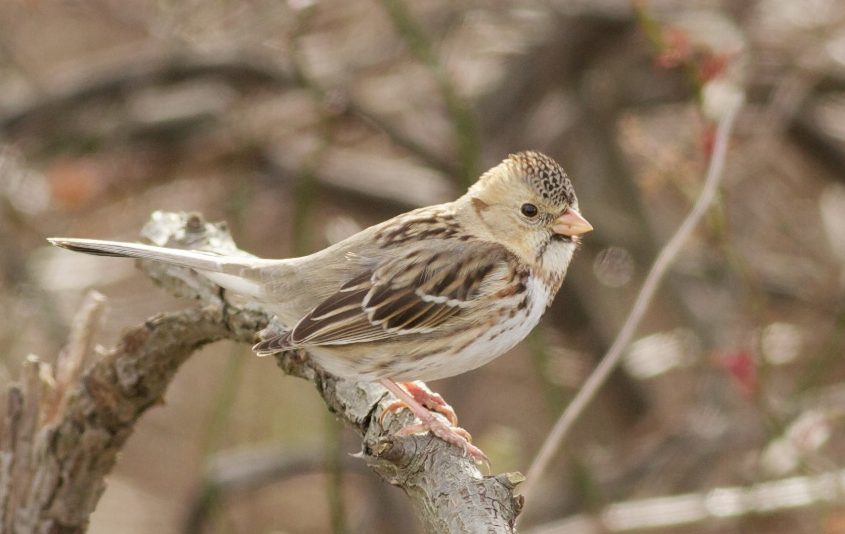
Harris’s Sparrow, Tom Johnson
Species on the Move
Beginning Arrivals What is this?
Peaking Arrivals
| Species | Noticeability | Migrants Begin Arriving | Rapid Migrant Influx | Peak | Rapid Migrant Departure | Last Migrants Depart |
|---|---|---|---|---|---|---|
| Trumpeter Swan | * | 17-Nov | 25-Nov | After Dec 31 | - | - |
Beginning Departures
| Species | Noticeability | Migrants Begin Arriving | Rapid Migrant Influx | Peak | Rapid Migrant Departure | Last Migrants Depart |
|---|---|---|---|---|---|---|
| Long-tailed Duck | * | 25-Oct | 7-Nov | 23-Nov | 9-Dec | 26-Dec |
| Ross's Goose | * | 19-Oct | 2-Nov | 23-Nov | 7-Dec | 19-Dec |
Ending Departures
| Species | Noticeability | Migrants Begin Arriving | Rapid Migrant Influx | Peak | Rapid Migrant Departure | Last Migrants Depart |
|---|---|---|---|---|---|---|
| American Coot | *** | 11-Sep | 3-Oct | 29-Oct | 21-Nov | 10-Dec |
| Northern Shoveler | *** | 11-Oct | 22-Oct | 6-Nov | 22-Nov | 5-Dec |
| Double-crested Cormorant | *** | 8-Sep | 25-Sep | 22-Oct | 24-Nov | 17-Dec |
| Horned Grebe | *** | 7-Oct | 20-Oct | 6-Nov | 24-Nov | 9-Dec |
| Redhead | *** | 10-Oct | 22-Oct | 7-Nov | 24-Nov | 8-Dec |
| Whooping Crane | * | 13-Oct | 24-Oct | 8-Nov | 24-Nov | 6-Dec |
| Common Loon | ** | 12-Oct | 24-Oct | 10-Nov | 26-Nov | 10-Dec |
| Canvasback | *** | 13-Oct | 25-Oct | 11-Nov | 27-Nov | 8-Dec |
West
The beginning and end of the period will see favorable conditions across the southern half of the region, with more favorable conditions extending to more areas late in the period. These conditions will spawn locally light to moderate flights, primarily waterfowl. Of particular note, birders in the southern Rockies should watch for more intense flights on Friday night; birders in the Pacific Northwest should watch for more intense flights on Tuesday night.
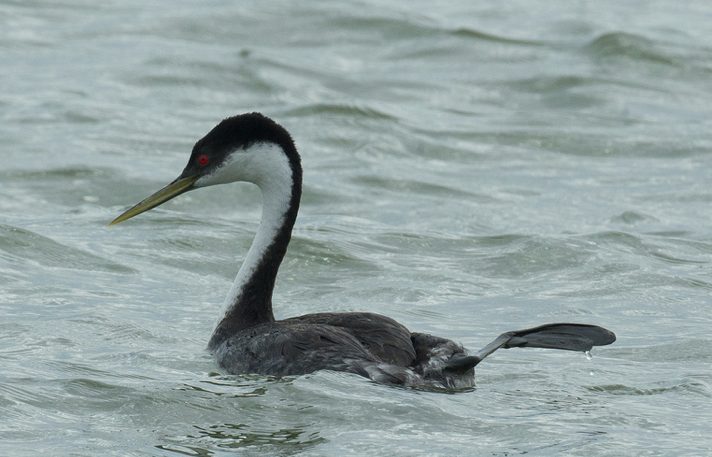
Western Grebe, Chris Wood
Species on the Move
Beginning Arrivals What is this?
Peaking Arrivals
| Species | Noticeability | Migrants Begin Arriving | Rapid Migrant Influx | Peak | Rapid Migrant Departure | Last Migrants Depart |
|---|---|---|---|---|---|---|
| Bohemian Waxwing | * | 22-Oct | 22-Nov | After Dec 31 | - | - |
Beginning Departures
| Species | Noticeability | Migrants Begin Arriving | Rapid Migrant Influx | Peak | Rapid Migrant Departure | Last Migrants Depart |
|---|---|---|---|---|---|---|
| American Wigeon | * | 3-Sep | 19-Oct | 20-Nov | 4-Dec | 16-Dec |
| Ring-billed Gull | ** | Before July 1 | 2-Nov | 22-Nov | 5-Dec | - |
| Bufflehead | ** | 15-Oct | 29-Oct | 22-Nov | 3-Dec | 10-Dec |
| Cackling Goose | * | 18-Sep | 5-Oct | 22-Nov | 7-Dec | 19-Dec |
| Canvasback | * | 11-Oct | 28-Oct | 23-Nov | 4-Dec | 11-Dec |
| Herring Gull | * | 22-Sep | 24-Oct | 26-Nov | 11-Dec | After Dec 31 |
| Hooded Merganser | * | 18-Oct | 2-Nov | 26-Nov | 6-Dec | 14-Dec |
| Ross's Goose | * | 24-Oct | 7-Nov | 26-Nov | 7-Dec | 14-Dec |
Ending Departures
| Species | Noticeability | Migrants Begin Arriving | Rapid Migrant Influx | Peak | Rapid Migrant Departure | Last Migrants Depart |
|---|---|---|---|---|---|---|
| Dunlin | * | 22-Sep | 11-Oct | 6-Nov | 24-Nov | 8-Dec |
| Western Grebe | *** | 15-Sep | 14-Oct | 5-Nov | 24-Nov | 9-Dec |
| California Gull | ** | Before July 1 | 14-Jul | 9-Nov | 26-Nov | 10-Dec |
| American Tree Sparrow | * | 11-Oct | 24-Oct | 15-Nov | 26-Nov | 7-Dec |
| Black Turnstone | * | 3-Jul | 19-Jul | 14-Sep | 26-Nov | 7-Dec |
| Bonaparte's Gull | *** | 13-Oct | 24-Oct | 10-Nov | 26-Nov | 9-Dec |
| Horned Grebe | ** | 21-Sep | 18-Oct | 11-Nov | 26-Nov | 6-Dec |
| White-winged Scoter | * | 20-Sep | 22-Oct | 10-Nov | 26-Nov | 7-Dec |
–––––––––––––––––––––––––––––––––––
Farnsworth and Van Doren




